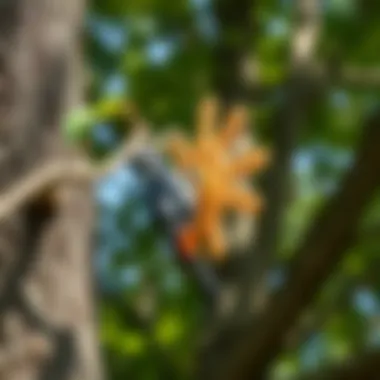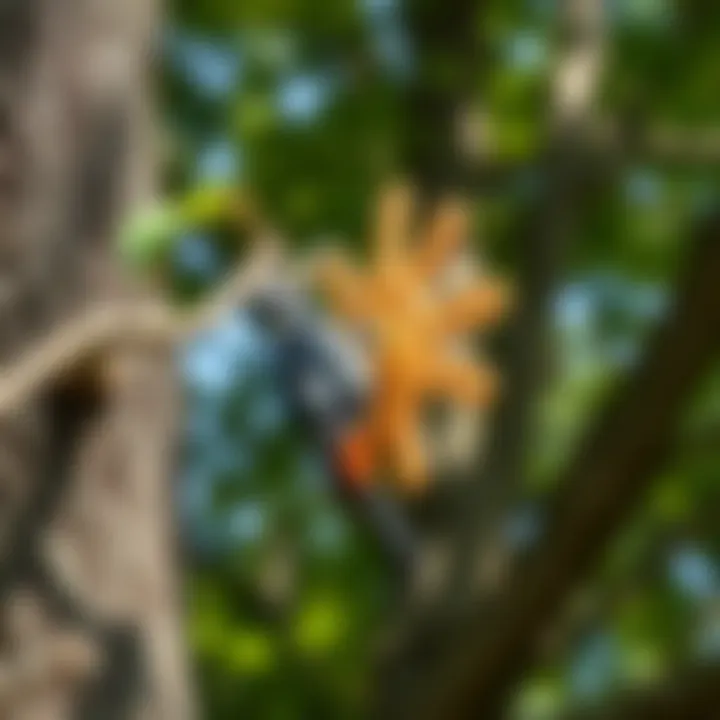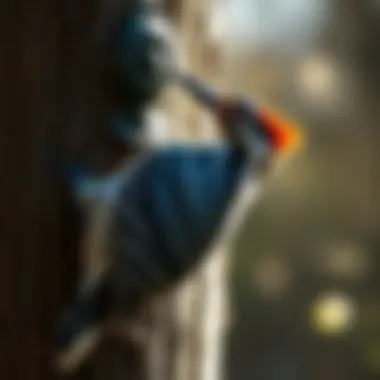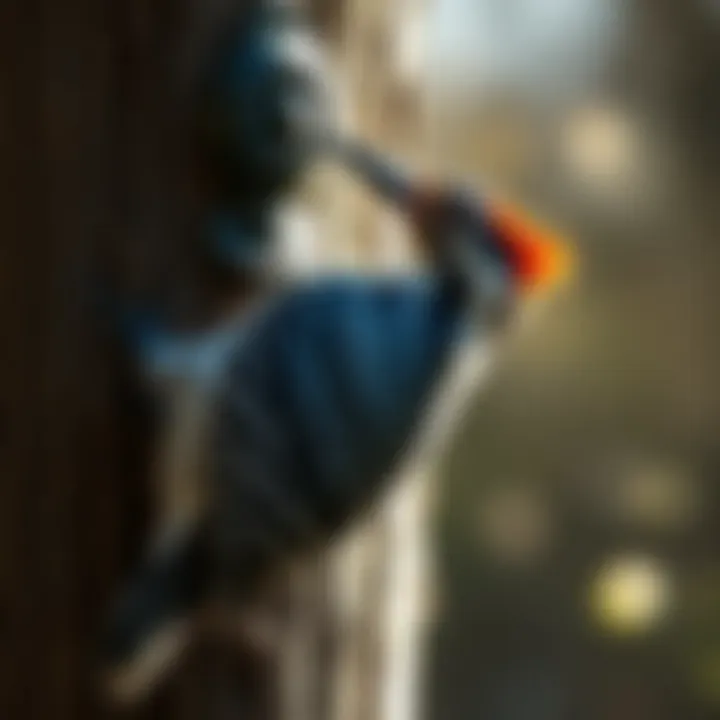Woodpecker Deterrent Devices: A Homeowner's Guide


Intro
The sound of a woodpecker's relentless tapping can be a source of both fascination and frustration. While one might admire these birds in a documentary or from afar, the reality of them drilling into the sides of your home can change that admiration to annoyance. This guide aims to unpack the complexities surrounding woodpecker behavior and the potential damages they can inflict on properties. Furthermore, it will introduce various deterrent devices that appear to be effective in mitigating their impact.
By understanding woodpecker habits and the types of available deterrent solutions, readers will be better positioned to protect their homes without causing harm to these intriguing creatures. As awareness grows about the importance of ecological balance, this guide seeks to equip homeowners, especially housewives and other property owners, not only with practical solutions but also the knowledge that fosters respectful coexistence with nature.
Foreword to Woodpecker Behavior
Woodpeckers are fascinating creatures, yet their habits can often create a significant headache for homeowners. Understanding their behavior is the first step toward managing them effectively. For many, this isn’t just about noise or aesthetics; it's about preserving the integrity of their property. Woodpeckers, known for their persistent drilling, can turn a peaceful home into a canvas for their relentless pecking. This article sets out to unpack the complexities of woodpecker behavior, focusing on their habits and the issues that arise when they invade our living spaces.
Understanding Woodpeckers and Their Habits
Woodpeckers are not just avian oddities; they play an essential role in our ecosystem. These birds are primarily drawn to trees, where they feast on insects, especially larvae that dwell beneath the bark. Their pecking is not merely an act of vandalism; it serves multiple functions. For example, woodpeckers create nesting cavities and search for food. Additionally, their drumming acts as a means of communication and territory establishment. If you were to observe a woodpecker in the wild, you’d see them working tirelessly, tapping rhythmically against tree trunks and sometimes, unfortunately, on wooden structures.
Homeowners often discover that woodpeckers are attracted to certain materials, such as the siding of houses or even telephone poles, presenting a hefty problem if left unchecked. A woodpecker pecking at your home isn’t simply a nuisance; it can lead to extensive damage over time. Recognizing and understanding these habits can empower you, the homeowner, to take the necessary steps to protect your property.
Why Woodpeckers Drilling Can Be Problematic
When woodpeckers choose your house as their personal playground, they can inflict more than surface damage. The persistent drilling can compromise the structural integrity of homes if it persists over time. Not to mention, there’s the additional headache of potential pest infestations that could arise when woodpeckers make access points for other insects. The blend of their quest for food and nesting in urban settings has resulted in an uneasy coexistence with humans.
It's crucial to recognize that woodpecker damage isn’t just skin deep. These birds can do considerable harm to wooden beams and support structures. In essence, if you notice your home resembling Swiss cheese, it might be time to address the issue. Additionally, the sounds of pecking can disturb peaceful living environments, leading to frustration among inhabitants.
Thus, understanding the implications of woodpecker behavior in urban spaces is paramount. This knowledge arms homeowners with the ability to implement effective deterrents and avoid costly repairs, striking a balance between appreciating nature and protecting their homes.
Remember, addressing woodpecker behavior is not just about the immediate nuisance—it’s about the long-term integrity of your home.
Common Types of Woodpecker Deterrent Devices
Managing woodpecker issues often starts with understanding the various deterrent devices available. These devices serve as a first line of defense against the damage that woodpeckers can inflict on your property. Each type has its distinct advantages and considerations, catering to different homeowner needs and preferences. By utilizing appropriate deterrents, one can protect their home while also being mindful of the ecological implications. The right choice not only secures your property but can also enhance its aesthetic appeal.
Visual Deterrents
Visual deterrents leverage the natural tendencies of woodpeckers to avoid threats. They introduce elements that confuse or scare off these birds, making your home a less inviting target.
Reflective Surfaces
Reflective surfaces are one of the most common visual deterrents. These can include shiny objects like aluminum foil, old CDs, or specialized reflective tape. The light glinting off these surfaces mimics the flash of predators' eyes or other threats. Homeowners often choose reflective surfaces because they are inexpensive and easy to install. An additional benefit is their aesthetic versatility; they can be incorporated without seeming out of place in your garden. However, the key characteristic of reflective surfaces is their dynamic flashing, which may lose efficacy during adverse weather conditions, as clouds can diminish their effect.
Decoy Predators
Using decoy predators is another effective approach. These are models of larger birds, like hawks or owls, placed strategically around your home. Woodpeckers instinctively avoid areas where they perceive the presence of a threat, which can be useful in deterring them. A striking (and often windy) feature of decoys is their eye-catching designs, which can draw attention away from your house. However, it's important to periodically change their positions or styles, as woodpeckers can eventually grow accustomed to their presence, rendering them less effective over time.
Auditory Deterrents
Auditory deterrents provide a soundbased approach to keeping woodpeckers at bay. By leveraging sounds that signify danger, homeowners can create an environment that feels threatening to woodpeckers.
Ultrasonic Devices
Ultrasonic devices emit high-frequency sounds that are undetectable to humans but irritating for birds like woodpeckers. These devices work continuously without the need for any manual interference, making them extremely convenient. One key aspect of ultrasonic devices is their continuous nature; once set up, they remain active. However, some options may only be effective within a limited range, meaning they might not cover a larger property fully. Homeowners need to check their specifications carefully to ensure the right fit.
Recording of Predator Calls


Recording of predator calls can be a more hands-on solution. This method involves playing back the sounds of birds of prey that naturally hunt woodpeckers. The idea behind this tactic is simple: by simulating the sounds of danger, woodpeckers will think twice about lingering around. One significant advantage of this approach is its direct engagement; it is an active deterrent that homeowners can control. On the downside, maintaining a consistent playback can be cumbersome, and it may also disturb other wildlife or neighborhood noise levels, so it's vital to use judiciously.
Physical Barriers
Physical barriers serve as a more permanent solution to foreclose woodpecker access altogether. These solutions not only deter the birds but also protect your home more effectively from damage.
Mesh Netting
Mesh netting acts as a physical barrier that provides homeowners with a robust line of defense against woodpeckers. One key feature of mesh netting is its versatility; it can be tailored to fit various structures such as trees, homes, and fencing. It's typically made from durable materials that withstand weather conditions while still being lightweight. However, if not installed correctly, mesh can sag or become damaged, leading to potential gaps that birds could exploit. So, proper installation is crucial.
Woodpecker-proof Siding
Another highly effective measure is woodpecker-proof siding, which is built specifically to withstand woodpecker attacks. This type of siding usually incorporates materials that are harder for woodpeckers to perforate, like composite or synthetic options. The durability of woodpecker-proof siding is undeniable, often lasting longer than standard siding under bird assaults. However, its installation can be costly, which might deter some homeowners from this option.
In essence, each deterrent offers unique advantages and considerations. By exploring these options and understanding their implications, homeowners can effectively safeguard their properties against woodpeckers while exploring solutions tailored to their needs.
By analyzing these common types of deterrent devices, owners can select a combination that best suits their situations, balancing effectiveness with practicality.
Evaluating the Effectiveness of Deterrents
When it comes to managing woodpecker issues, not all deterrent devices are created equal. Evaluating the effectiveness of these deterrents is essential for homeowners looking to protect their properties without causing harm to these birds or disrupting the surrounding ecosystem. Knowing how well various strategies work—and understanding the factors that contribute to their success—can help individuals make informed decisions.
The evaluation process often involves looking into several key factors like the specific woodpecker species involved, the environment they're in, and the nature of the damage they cause. This ensures that the methods employed are not only effective but also humane. Moreover, understanding deterrents' longevity and adaptability can ultimately save time and resources, giving homeowners peace of mind.
Factors Influencing Deterrent Success
The success of woodpecker deterrents hinges on multiple factors, including the specific characteristics of the woodpecker species and the type of environment in which they are found. Below are some points to consider:
- Species Variation: Different woodpecker species have varying behaviors and preferences. For instance, the Downy Woodpecker may respond differently to a visual deterrent compared to the Pileated Woodpecker. Understanding the species in question is crucial.
- Environmental Context: The location plays a significant role. An urban setting with ample artificial surfaces might affect how a woodpecker perceives threats differently than a heavily wooded area.
- Consistency of Application: How consistently the deterrents are applied can greatly influence their effectiveness. Regular maintenance and repositioning might be necessary to keep woodpeckers from becoming accustomed to the deterrents.
- Time of Year: Seasonal changes can impact woodpecker behavior. For example, during mating season, they might be more aggressive and less likely to be deterred.
- Types of Deterrent Used: Some devices, such as those based on auditory signals, may prove more effective in certain contexts than visual deterrents. Experimentation may be needed to find the right combination.
Case Studies: What Works and What Doesn't
To truly grasp the effectiveness of deterrent devices, it is beneficial to dive into specific case studies that illuminate what strategies have yielded results and which ones fell flat.
Successful Strategies
- Reflective Surfaces: Homeowners who installed reflective tape on wooden surfaces reported a noticeable decrease in woodpecker activity. The light bouncing off the surfaces seemed to confuse and deter the birds, leading to a significant reduction in pecking.
- Predator Decoys: In one suburban neighborhood, the usage of decoy owls resulted in dramatic success. The placement of these decoys on rooftops effectively discouraged woodpeckers from approaching, as they truly seemed wary of the perceived threat.
Unsuccessful Strategies
- Ultrasonic Devices: On the flip side, some homeowners have had less luck with ultrasonic deterrents. Reports indicated that both woodpeckers and homeowners often failed to notice any significant changes in behavior. This suggests that sound-based solutions might not be universally effective.
- Visual Deterrents That Blend In: Sometimes, homeowners choose visual deterrents that do not stand out enough, rendering them ineffective. It's essential for these deterrents to be prominent; otherwise, woodpeckers may ignore them altogether.
Thorough evaluation of available methods ensures homeowners can make the best choice. Testing different strategies tailored to specific circumstances might ultimately lead to a harmonious living situation for both humans and woodpeckers.
In summary, evaluating the effectiveness of woodpecker deterrents is not a one-size-fits-all approach. By examining the elements influencing their success and drawing insights from various case studies, homeowners can effectively address this issue while preserving the balance of their local ecosystem.
Eco-Friendly Approaches to Woodpecker Control
When faced with the challenges posed by woodpeckers, many homeowners may instinctively gravitate towards chemical solutions or physical deterrents. However, there lies a more sustainable path that prioritizes harmony with nature. By adopting eco-friendly approaches to controlling woodpecker activity, one can not only mitigate the damage caused by these birds but also foster a balanced ecosystem. This section delves into the significance and advantages of such strategies, showcasing their practical implementation and long-term benefits.
Using Natural Deterrents


Natural deterrents offer a promising avenue for influencing woodpecker behavior without resorting to harmful chemicals. These methods often promote coexistence rather than exclusion, allowing homeowners to appreciate the beauty of these birds while minimizing property damage. Let’s explore two effective tactics under this umbrella:
Planting Specific Trees
Planting specific trees is not only an attractive option for enhancing your yard's appearance, but it also serves as a direct method of influencing woodpecker activity. Certain tree species, such as black locust or particular varieties of oaks, are known to attract woodpeckers. By providing alternative food sources in your backyard, you might deter these birds from choosing your home as a drilling site.
Key characteristic: These trees typically produce insects that woodpeckers feed on, which could re-direct their foraging behavior.
A significant benefit of this method is that it fosters a diverse ecosystem while transforming your yard into a bird-friendly haven. However, opting for the wrong species might inadvertently invite more woodpeckers than expected, as they may prefer certain trees over others. Careful selection is crucial.
Creating Unwelcome Environments
Consider the idea of creating unwelcome environments as a more environmentally sound solution to woodpecker challenges. This approach involves reshaping your outdoor space in ways that make it less appealing for woodpeckers to frequent. For instance, eliminating standing water and ensuring that your garden is free from dead trees can dissuade woodpeckers from dwelling in the area.
Key characteristic: A clutter-free garden not only looks appealing but sends a message to woodpeckers that the habitat lacks the resources they require.
The advantage of this tactic is that it encourages healthy plant growth while simultaneously discouraging unwanted wildlife. Despite its benefits, this approach requires continuous upkeep to maintain the desired conditions and can demand a thoughtful design to strike a balance between beauty and functionality.
In Summary: Eco-friendly methods, such as planting specific trees and creating unwelcome environments, provide viable alternatives to more aggressive control methods. These techniques underscore the importance of a balanced relationship with nature, ultimately leading to a cooperative coexistence with woodpeckers while minimizing property damage.
DIY Solutions for Homeowners
When it comes to tackling the woodpecker dilemma, many homeowners prefer DIY solutions. These can be both cost-effective and empowering. Making your own deterrents gives you a sense of control over the situation. You get to craft your approach and learn in the process. It’s akin to cooking—sometimes, you need to adjust the recipe based on what you have in the pantry. Similarly, when dealing with woodpeckers, your personal touch can make all the difference.
Creating Homemade Deterrents
Repurposed Materials
Using repurposed materials is a clever way to create deterrents. Not only does it save you a few bucks, but it also promotes sustainability. Think of old CDs or aluminum foil. When sunlight hits these surfaces, they reflect light, creating an unsettling flash for the woodpeckers. This makes them think twice about pecking at your home.
One of the key characteristics of repurposed materials is versatility. Almost any item that can reflect light or create noise can be transformed into a deterrent. You might find old wind chimes that you’ve long forgotten in your garage. When hung strategically, they can produce sounds that disrupt the woodpecker's focus.
However, one unique feature of using repurposed materials is that they can work only to a certain degree. While they might deter woodpeckers temporarily, their effectiveness can diminish over time. Woodpeckers are intelligent and can adapt. So, you may need to change your approach frequently.
Low-Cost Options
Low-cost options for deterring woodpeckers can be quite effective as well. Basic items like used plastic bottles can be filled with stones and hung around your property. The rattling noise caused by the stones colliding can unsettle the birds. It’s a low-tech way that’s gentle on the wallet but might carry some significant benefits.
When you consider what makes low-cost options appealing, immediate availability is a big factor. You can often find these materials around your home or at local stores without breaking the bank. This means you can implement your deterrents swiftly.
Interestingly, the unique feature of low-cost options is how straightforward they are to create. You don’t need any specialized skills or tools. Just a bit of creativity and elbow grease can go a long way. However, a disadvantage is that some of these solutions may not last long, especially in inclement weather. Thus, you might find yourself having to replace them more often than not.
It's essential to remember that combining these DIY solutions with other methods for woodpecker deterrence might yield the best results.
Professional Pest Control Services
The issue of woodpecker damage can often spiral out of control for homeowners, making the idea of professional pest control services not only appealing but sometimes essential. Hiring experts comes with a range of benefits that can greatly enhance the effectiveness of your efforts to manage these birds. Unlike DIY methods, which often yield inconsistent results, a professional provides tailored solutions based on extensive knowledge and experience.
Investigating this approach begins with an understanding of the complexities behind woodpecker behavior. They tend to be drawn to certain aspects of residential landscaping and home architecture. This knowledge helps professionals identify the root causes of the problem and apply the most effective deterrent strategies. Furthermore, pest control experts are familiar with current regulations regarding bird protection, thereby ensuring that all methods adhere to legal standards.
When to Seek Professional Help


Recognizing when to call in the pros can be tricky. If you've already tried a variety of DIY solutions without any luck, it's likely a sign that professional help is needed. Here are some scenarios when seeking assistance makes sense:
- Persistent Damage: If woodpeckers are consistently damaging your property and DIY methods aren't cutting it, it could be time to bring in a specialist.
- Dangerous Reach: When woodpeckers target higher or hard-to-reach areas, attempting to fix the issue yourself can be risky.
- Larger Impact: If the problem extends beyond just your home, affecting neighboring properties or local wildlife, it may necessitate a broader, coordinated approach that a professional can provide.
What to Expect from a Pest Control Expert
When you decide to hire a pest control expert, it’s crucial to have an understanding of their methods and what you can expect:
- Initial Assessment: The expert will evaluate the extent of the damage and identify potential attractants that may be luring the woodpeckers.
- Customized Plan: Based on the assessment, they will create a personalized plan that summarizes effective deterrents tailored specifically to the conditions of your property.
- Implementation: They will skillfully put in place the deterrent devices or strategies, ensuring they are effectively installed and positioned for maximum impact.
- Follow-Up: Good professionals will not just leave you hanging. They often schedule follow-up visits to assess the effectiveness of the solutions and make any necessary adjustments.
"Expertise in pest control means more than just removing the problem; it involves understanding the ecosystem, ensuring legal compliance, and integrating long-term solutions."
By involving a professional pest control service, homeowners can focus on their day-to-day lives while knowing that woodpecker management is in capable hands. Such services can truly offer peace of mind and a lasting resolution to these persistent feathered foes.
Legal Considerations in Woodpecker Management
Understanding the legal aspects of managing woodpecker populations is crucial for homeowners. This section dives into the specific elements of bird protection laws and the importance of permits, offering insights into achieving effective woodpecker deterrence while adhering to conservation regulations.
Understanding Bird Protection Laws
Bird protection laws are designed to safeguard avian species, and woodpeckers are no exception. Many species are protected under the Migratory Bird Treaty Act, which makes it unlawful to harm, capture, or kill migratory birds without a permit. This legislation highlights the importance of considering legal ramifications before taking any action against woodpeckers that invade your residential space.
Unraveling these laws can be tricky, but it's essential to know that intentional harm to these birds can result in hefty fines or legal actions. It's not just about protecting the woodpecker; it’s about preserving the ecosystem, where every species plays a vital role. For instance, woodpeckers can be beneficial for controlling insect populations. Therefore, before proceeding with any deterrent methods, familiarizing oneself with local and federal laws is critical.
Permits and Their Importance
When it comes to managing woodpecker populations, obtaining the necessary permits may be unavoidable. The rationale behind requiring permits is simple: it ensures that any intervention is humane and legally compliant. In many instances, homeowners may think that removing the bird or its nest is the only solution for their woes. However, without the right permit, such actions could lead to harsher consequences.
Permits can serve as a protective measure not just for the birds, but also for the homeowners. They provide a structured framework for managing wildlife that can minimize health risks and property damage.
Some of the benefits of acquiring permits include:
- Legal Protection: Having the proper documentation shields homeowners from potential fines.
- Guidance from Authorities: Permits often come with specific instructions on what methods are suitable for controlling bird populations.
- Responsible Practices: Engaging with legal frameworks promotes ethical behavior in wildlife management.
In summary, while the struggle with woodpeckers can be frustrating, navigating the legal landscape is essential in ensuring that any actions taken are both effective and responsible. Keep in mind that knowing the laws not only helps protect the woodpeckers but also empowers homeowners to make informed decisions that benefit both their property and the environment.
The End: Striking a Balance
The relationship between homeowners and woodpeckers is more complex than it often appears at first glance. On one side, you have these industrious birds that play a crucial role in the ecosystem, aiding in pest control and tree health. On the other, there are the damages they can inflict on structures, leading to costly repairs and a fair bit of frustration. The key, then, is finding a harmonious approach that respects the woodpeckers' importance while safeguarding your property. This balance can be achieved through an informed strategy that combines various methods and respects the legal protections surrounding these birds.
Combining Strategies for Optimal Results
When it comes to effectively managing woodpecker activity, using a single method is often not enough. An effective strategy must be multifaceted, incorporating different types of deterrents tailored to address both behavioral and environmental factors. For instance:
- Visual Deterrents: Encountering reflective surfaces or decoy predators can discourage woodpeckers from approaching your property in the first place. Creative placement of such items can significantly enhance their effectiveness.
- Auditory Measures: Devices that emit predator calls or natural phishing sounds work wonders when combined with other methods. The sound can unsettle woodpeckers and drive them away.
- Physical Barriers: Using mesh netting or woodpecker-proof siding acts as a last line of defense, preventing them from causing damage even if other deterrents are ignored.
Furthermore, continuously evaluating the effectiveness of these strategies is crucial. What works in one season may not be as effective in another, so homeowners should remain vigilant and flexible, adapting their approaches as necessary. By integrating various deterrent methods into a cohesive plan, homeowners are more likely to achieve long-term success in maintaining a woodpecker-free environment.
Long-term Management Practices
Effective woodpecker management is not a one-time job; it requires ongoing effort and adaptability. Long-term practices include:
- Monitoring Woodpecker Activity: Keep a keen eye on the frequency of visits and types of damage incurred. This first-hand information can inform adjustments to your strategy.
- Habitat Modification: Altering the environment around your property can deter woodpeckers from lingering too long. This might mean eliminating food sources, like removing dead trees or infested wood. More often than not, woodpeckers will drift elsewhere when their dining options dwindle.
- Regular Maintenance: Routinely check for vulnerabilities in home exteriors that could attract woodpeckers and lead to sustained damage. Quick repairs on minor issues can save larger costs down the line.
Simply put, being proactive about these practices ensures that homeowners are well-equipped to handle any woodpecker issues that may arise down the line. Taking an informed, balanced approach is the crux of effective woodpecker management, allowing you to protect your home while safeguarding the ecological roles these birds fulfill.
Achieving harmony between protecting property and respecting wildlife isn't just beneficial for homeowners—it's a step towards sustainable living.
For more resources on bird behavior and habitat management, consider visiting Wikipedia or Britannica, offering a wealth of knowledge on ecological sensitivity.



